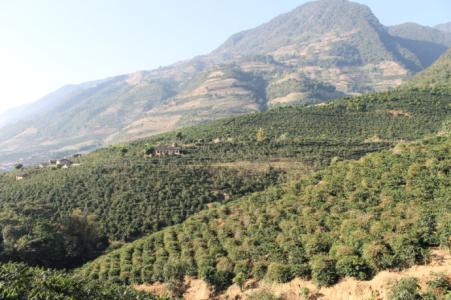Flavor description of Katim Coffee Bean introduction to the characteristics of varieties produced by taste treatment
This variety is a variety with high and stable yield. The results of trial planting in different ecological areas show that as long as it is planted in accordance with high-yield cultivation techniques, a higher yield will be obtained, with an average yield of more than 150 kg per mu and a small area of more than 400 kg.
Katim is the biggest harvest country of this new variety, and the improved Katim with the national name "Colombia" Katim and Kaddura are their two main varieties, with a proportion of about 6:4. These were told by my Colombian colleagues during the 2010 World Expo as a Chinese coffee consultant in Costa Rica. So those friends who flip through the coffee beans printed in the Supermo bag and say how Katim in Yunnan had no flavor last time, please pay more attention to the coffee in Yunnan.

1. The state-run Lujiang Farm in Baoshan City planted 12.6 mu in March 1991. The land is unshaded and irrigated once in the dry season. The level of management and fertilization is above. In 1993, the average yield per mu was 75 kg in 1993, 350 kg in 1994, 225 kg in 1995, 217 kg in 1996, and 36% higher than Tiebika and Bobang (160 kg per mu).

2. Yunnan Dehong Tropical Agricultural Science Research Institute 1991 planted 30 mu with no shade and anhydrous irrigation, with a medium level of fertilization and management. the average yield per mu was 304.3 kg in 1993, 294 kg in 1994, 222.5 kg per mu in 1995, 273.6 kg per mu in 1995 and 1996, and 82% higher than that of S288 (S288).
Important Notice :
前街咖啡 FrontStreet Coffee has moved to new addredd:
FrontStreet Coffee Address: 315,Donghua East Road,GuangZhou
Tel:020 38364473
- Prev

Description of Flavor of Kilimanjaro Coffee Bean by Grinding scale method
Tanzania's main coffee producing area, located at the foot of Mount Kilimanjaro, is rich in volcanic soil. Some coffee trees planted here are more than 100 years old. Coffee was first introduced by Christians from Kenya to grow coffee. Coffee trees must be carefully taken care of, weeded and fertilized. And old branches must be cut off so that new branches can grow to maintain the quality of coffee beans.
- Next

How to introduce the taste, price and flavor characteristics of Colombian Huilan coffee
Colombia Huilan coffee taste price how to introduce Colombia's rich products, especially coffee, flowers, gold and emeralds are known as the four treasures. In 1808, a priest introduced coffee to Colombia for the first time from the French Antilles via Venezuela. Today, the country is the second largest coffee producer after Brazil and the largest Arabica coffee bean producer in the world.
Related
- Detailed explanation of Jadeite planting Land in Panamanian Jadeite Manor introduction to the grading system of Jadeite competitive bidding, Red bid, Green bid and Rose Summer
- Story of Coffee planting in Brenka region of Costa Rica Stonehenge Manor anaerobic heavy honey treatment of flavor mouth
- What's on the barrel of Blue Mountain Coffee beans?
- Can American coffee also pull flowers? How to use hot American style to pull out a good-looking pattern?
- Can you make a cold extract with coffee beans? What is the right proportion for cold-extracted coffee formula?
- Indonesian PWN Gold Mandrine Coffee Origin Features Flavor How to Chong? Mandolin coffee is American.
- A brief introduction to the flavor characteristics of Brazilian yellow bourbon coffee beans
- What is the effect of different water quality on the flavor of cold-extracted coffee? What kind of water is best for brewing coffee?
- Why do you think of Rose Summer whenever you mention Panamanian coffee?
- Introduction to the characteristics of authentic blue mountain coffee bean producing areas? What is the CIB Coffee Authority in Jamaica?

